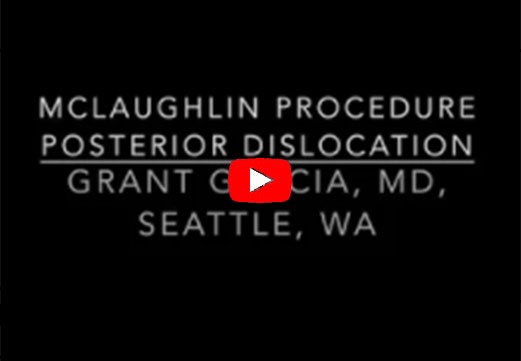posterior labral repair
Content below from orthobullets.com
Posterior Labral Tears and Repair
- Definition
- commonly referred to as a reverse Bankart lesion, or attenuation of the posterior capsulolabral complex
- Epidemiology
- athletes
- weightlifters (bench press)
- football linemen (blocking)
- swimmers
- gymnasts
- wrestlers
- athletes
- Pathophysiology
- repetitive microtrauma to the posterior capsulolabral complex
- most common mechanism
- posteriorly directed force with the arm in a flexed, internally rotated and adducted position
- glenoid retroversion
- patients with increased glenoid retroversion (~17°) were 6x more likely to experience posterior instability compared to those with less glenoid retroversion (~7°)
- repetitive microtrauma to the posterior capsulolabral complex
- Associated injuries
- Kim lesion
- an incomplete and sometimes concealed avulsion of posteroinferior labrum
- Kim lesion
- Posterior labrum
- function
- helps generate cavity-compression effect of glenohumeral joint
- creates 50% of the glenoid socket depth
- provides posterior stability
- anatomy
- composed of fibrocartilagenous tissue
- anchors posterior inferior glenohumeral ligament (PIGHL)
OSS Shoulder Dislocation and Labral Tears
- function
- Symptoms
- vague, nonspecific posterior shoulder pain is the most common symptoms
- worsens with provocative activities that apply a posteriorly directed force to the shoulder
- ex: pushing heavy doors, bench press, push-ups
- worsens with provocative activities that apply a posteriorly directed force to the shoulder
- clicking or popping in the shoulder with range of motion
- sense of instability
- less common
- pain during throwing
- late cocking phase
- vague, nonspecific posterior shoulder pain is the most common symptoms
- Physical exam
- posterior joint line tenderness
- provocative tests
- posterior apprehension test
- arm positioned with shoulder forward flexed 90° and adducted
- apply anterior support to scapula
- apply posteriorly directed force to shoulder through humerus
- positive if patient experiences sense of instability or pain
- posterior load and shift test
- patient rests arm at their side
- grasp the proximal humerus and apply a posteriorly directed force
- assess distance of translation and patient response
- grade 0 = no translation
- grade 1 = to edge of glenoid
- grade 2 = over edge of glenoid but spontaneously relocates
- grade 3 = over edge of glenoid, does not spontaneously relocate
- jerk test
- arm positioned with shoulder abducted 90° and fully internally rotated
- axially load humerus while adducting the arm across the body
- clunk indicates subluxation of the humeral head off the posterior glenoid
- highly sensitive and specific for a posterior labral tear
- kim test
- arm positioned with shoulder abducted 90° and forward flexed 45°
- apply posteriorly and inferiorly directed force to shoulder through humerus
- positive if patient experiences pain
- highly sensitive and specific for posteroinferior labral tear
- Nonoperative
- activity modification, NSAIDs, PT
- indications
- first line of treatment
- technique
- rotator cuff and deltoid strengthening
- periscapular stabilization
Dr. Garcia demonstrates his technique for locked posterior dislocation (Modified Mclaughlin Procedure)
- indications
- activity modification, NSAIDs, PT
- Operative
- posterior labral repair, capsulorrhaphy
- indications
- extensive nonoperative management fails
- extensive nonoperative management fails
- technique
- arthroscopic and open techniques may be used
- arthroscopic preferred to open given the extensive posterior surgical dissection required
- more reliable return to play
- suture anchor repair and capsulorrhaphy results in fewer recurrences and revisions than non-anchored repairs
- indications
- posterior labral repair, capsulorrhaphy
- outcomes
- generally good
- return to previous level of function in overhead throwing athletes not as reproducible as other athletes
- failure risk increases if adduction and internal rotation are not avoided in the acute postoperative period
Check out this video testimonial after bilateral labral repairs with biceps tenodesis
Dr. Garcia demonstrates his arthroscopic surgical technique for anterior labrum “Bankart” repair.
Dr. Garcia demonstrates his repair technique for posterior shoulder instability
for more information visit orthobullets.com



















